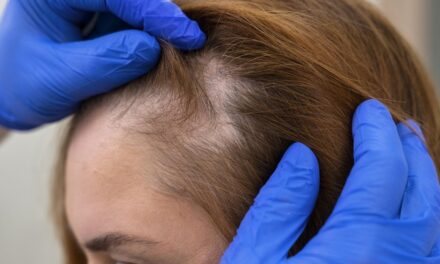
Are you a new mother experiencing postpartum hair loss? You’re not alone. Many women experience this common condition, which can be frustrating.
During pregnancy, hormones cause your hair to become thicker and fuller, but after birth, these levels drop, causing excess shedding. This comprehensive guide will help you understand why this happens and provide practical tips to help maintain the health of your hair during this time.
Becoming a mother is an exciting and life-changing experience but it can also be stressful. Don’t let postpartum hair loss add to that stress. With this guide, you can take control of your hair health and feel confident in your new role as a mom.
What Is Postpartum Hair Loss?
Postpartum hair loss refers to the shedding of an excessive amount of hair that occurs a few months after giving birth. This is due to hormonal changes that take place during and after pregnancy.
10 Ways To Deal With Postpartum Hair Loss
1. Use volumizing shampoos
One method that can help combat hair loss is using volumizing shampoos. A volumizing shampoo adds thickness and body to hair, giving the appearance of fuller, more voluminous locks. While they may not prevent hair from falling out, they can help make hair look more luxurious and hide any balding spots.
2. Take good care of your hair
Handling your fine hair carefully is important when washing and combing it. Using lower heat settings on blow dryers and styling irons is recommended to prevent damage. In addition, tight ponytails and braids can cause tension in your hair, leading to hair loss, so it’s best to avoid them.
3. Use lightweight conditioners that won’t weigh down your hair
Conditioners can help keep hair looking and feeling healthy, but it’s important to choose the right kind. Heavy conditioners may weigh your hair down, making it look limp or greasy. Instead, try using a lightweight conditioner for thin or thick hair, which will help nourish the scalp without weighing your hair down.
4. Take your prenatal vitamins and supplements
Taking prenatal vitamins and supplements can be beneficial for postpartum hair loss. They contain essential nutrients such as zinc, iron, and biotin, which help to promote healthy hair growth. Talk to your doctor about which ones are right for you.
5. Eat a balanced and healthy diet

It’s important to maintain a healthy diet during and after pregnancy. Eating a balanced and nutritious diet can help keep your hair looking and feeling its best. Foods such as fish, eggs, spinach, nuts, lentils, and avocados are all rich in vitamins and minerals essential for healthy hair growth.
6. Reduce stress
High levels of stress can cause additional hair loss, so it’s important to try and reduce your stress levels. Meditation, yoga, and even baths can all be great ways to reduce and help you feel more balanced.
7. Get regular trims
Getting regular trims can help keep your hair healthy and prevent further damage. This also helps eliminate split ends that can cause hair to break more easily.
8. Use the right styling products
Using the right styling products can help maintain healthy hair and reduce breakage. Look for products specifically designed to be gentle on the hair and scalp, such as those labeled “natural” or “for sensitive scalps.”
9. Changing your hairstyle
If you’ve tried various remedies and supplements to no avail, consider changing your hairstyle. For example, a shorter cut or layered style can give the appearance of thicker, fuller hair. Bangs can also be a great option to hide thinning patches around the front hairline.
Another option is to try hair extensions or a wig if you’re feeling particularly self-conscious about your hair loss. Don’t be afraid to experiment with different styles and textures until you find something that makes you feel confident and beautiful.
10. Wearing Accessories

One way to deal with postpartum hair loss is by wearing accessories. Accessories such as headbands, scarves, hats, or hair clips can help camouflage thinning hair and create a stylish look.
They also provide an easy way to switch up your hairstyle on days when you may not feel like dealing with your hair loss. Don’t hesitate to experiment with different styles and accessories to find what suits you best.
The Impact of Hormones on Your Hair
Hormones play a major role in the changes in your hair. This is especially visible during pregnancy and after giving birth.
High levels of estrogen during pregnancy slow down the normal rate of hair loss. Usually, pregnancy hair falls out in small amounts every day, but due to the increased blood volume and circulation, it happens less during pregnancy.
However, after giving birth and hormonal levels dropping, hair loss makes up for the lost time by falling out in big clumps, which can be scary and alarming. It is important to remember that the total volume of hair loss during this time is not more than what you would have lost in the last nine months, but it is only happening at once.
So, while hormonal changes can impact your hair, it is essential to understand that it is a natural process that eventually stabilizes with time.
How Long Does Postpartum Hair Loss Last?
For new moms, the postpartum period is full of changes – from sleepless nights to fluctuating hormones. One common change that many women experience is postpartum hair loss.
While it can be alarming to find clumps of hair in the shower, rest assured that this shedding is totally normal and usually peaks around four months after giving birth. So the good news is that when your little one celebrates their first birthday, your hair should be well on its way to regaining its usual thickness.
However, if you’re still experiencing excess hair loss beyond the one-year mark, consulting with a dermatologist may be worthwhile to rule out any underlying causes.
When to Be Concerned About Postpartum Hair Loss

Though postpartum hair loss is normal, certain signs may indicate a more serious issue. You must speak to your doctor immediately if you experience sudden and excessive shedding and other symptoms such as fatigue, fever, or headaches.
Additionally, if the hair shedding or chronic hair loss continues after one year of giving birth or doesn’t improve with self-care, consulting with a dermatologist may be beneficial.
These signs and symptoms could indicate an underlying cause that needs medical attention, so it is important to take any concerning changes in your hair seriously.
Final Thoughts
Postpartum hair loss is a common yet distressing problem for many new moms. The good news is that it typically goes away independently with time and proper care.
To manage and minimize postpartum hair loss, follow the tips mentioned above. If your hair loss continues beyond the one-year mark, it may be worth consulting with a dermatologist to rule out any underlying issues.
Above all, remember that it is completely normal to experience postpartum hair loss, and there are many ways to deal with it. With the right knowledge and care, you can take control of your postpartum hair loss journey.
Check out Vitamins Revive for their hair growth supplement specifically developed to help new moms manage postpartum hair loss. Formulated with an effective combination of vitamins and minerals, it can help reduce the shedding rate and support healthy hair growth. So get your bottle today and start seeing results!
FAQs
How to prevent postpartum hair loss?
Postpartum hair loss is an inevitable occurrence that cannot be prevented. However, being aware of it beforehand can prepare you so that it doesn’t come as a shock when it happens.
What helps with postpartum hair loss treatment?
A proper diet, regular exercise, and avoiding harsh chemicals on your hair are excellent methods for treating postpartum hair loss.
When does postpartum hair loss start?
Typically, new mothers experience the highest amount of hair shedding approximately four months after delivery.
What is a hair tourniquet?
A hair tourniquet is a strand of hair curled or entwined around the body part, such as a finger or toe, which can cause pain and swelling.
How long does postpartum hair loss take to grow back?
Typically, women’s hair growth cycle returns to normal within six months after giving birth. However, in some cases, it may take between 6 to 12 months.









